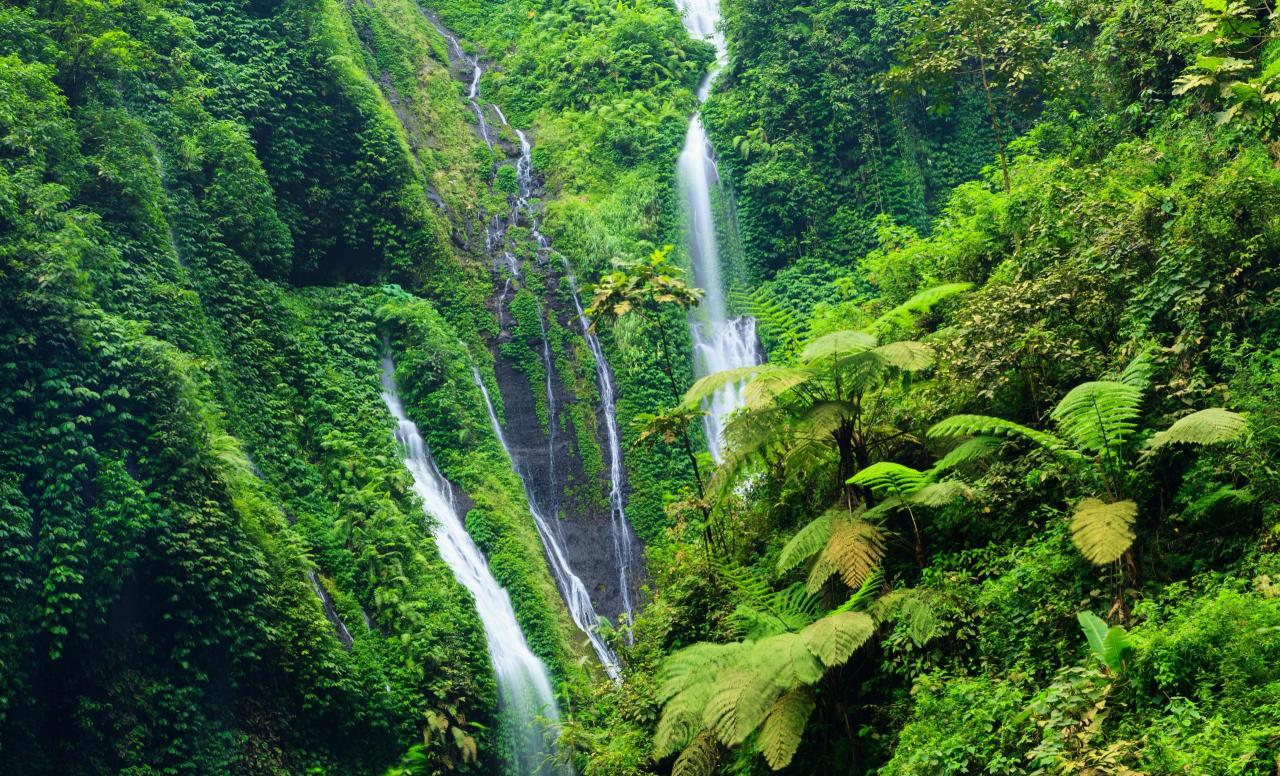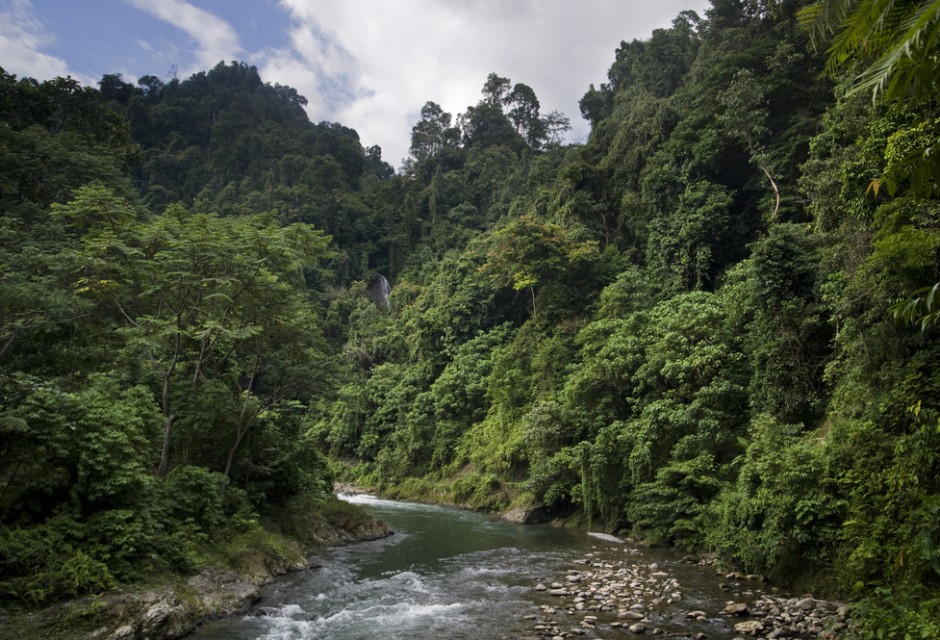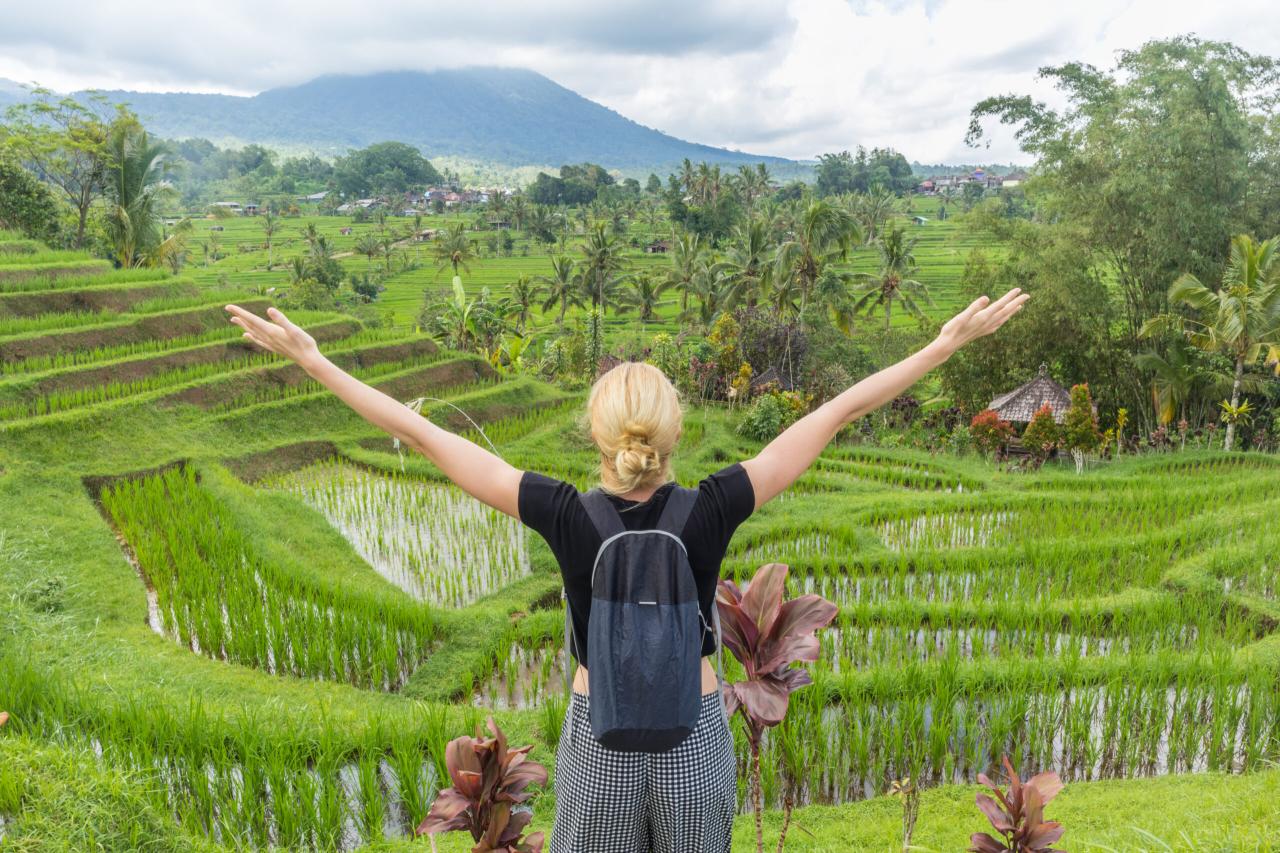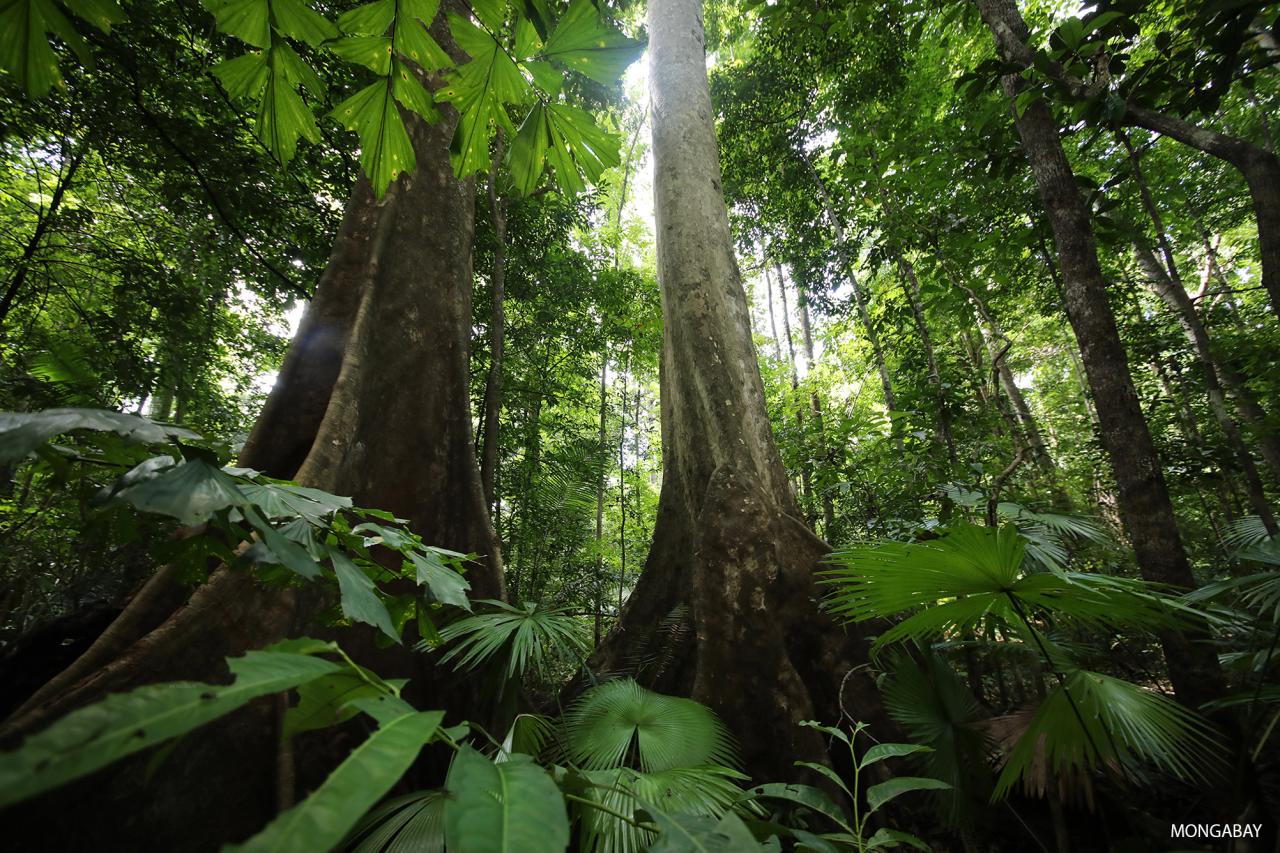Eco-friendly and sustainable tourism options in Indonesian rainforests are more crucial than ever. Indonesia’s lush rainforests, teeming with biodiversity and rich cultural heritage, face immense pressure from unsustainable tourism practices. This article delves into responsible ways to explore these incredible ecosystems, highlighting eco-lodges, community-based initiatives, and minimizing your environmental impact. From trekking through ancient jungles to encountering unique wildlife, we’ll uncover the best ways to experience the magic of Indonesian rainforests without harming their delicate balance.
We’ll explore various eco-friendly activities, sustainable transportation options, and the importance of community involvement. Learn how to choose accommodations that prioritize sustainability, understand the environmental impact of your choices, and discover initiatives that support local communities and conservation efforts. Let’s journey together into the heart of the rainforest, ensuring its preservation for generations to come.
Defining Eco-Friendly and Sustainable Tourism in Indonesian Rainforests

Indonesian rainforests, boasting unparalleled biodiversity, are increasingly attracting tourists. However, this influx presents a critical challenge: ensuring tourism’s impact remains positive. Eco-friendly and sustainable tourism practices are crucial to preserving these invaluable ecosystems for future generations. Understanding the nuances of these approaches is key to responsible travel in this unique environment.Eco-friendly and sustainable tourism in Indonesian rainforests centers on minimizing environmental damage and maximizing benefits for local communities.
Sustainable tourism prioritizes long-term ecological integrity and socio-economic well-being, encompassing environmental, social, and economic dimensions. Ecotourism, a subset of sustainable tourism, focuses specifically on environmentally responsible travel to natural areas, aiming to educate and conserve. While all ecotourism is sustainable, not all sustainable tourism is necessarily ecotourism; sustainable tourism has a broader scope encompassing the social and economic aspects.
Differences Between Ecotourism and Sustainable Tourism in Indonesian Rainforests
Ecotourism in Indonesian rainforests emphasizes direct conservation efforts. This could involve supporting local initiatives focused on rainforest protection, participating in reforestation projects, or choosing accommodations that actively invest in environmental sustainability. Sustainable tourism, while encompassing these elements, also considers the economic well-being of local communities. It involves ensuring that tourism revenue directly benefits local people, supporting fair wages, and promoting local businesses and crafts.
A sustainable tourism model might involve staying in locally owned hotels, purchasing goods from local artisans, and engaging in activities that support the livelihoods of the community. The key difference lies in the emphasis: ecotourism prioritizes environmental conservation, while sustainable tourism takes a more holistic approach, integrating environmental, social, and economic considerations.
Examples of Unsustainable Tourism Practices in Indonesian Rainforests
Unsustainable tourism practices in Indonesian rainforests pose significant threats to the environment and local communities. These practices often prioritize profit over environmental protection and community well-being.Several examples highlight this issue. One common problem is the irresponsible disposal of waste, leading to pollution of rivers and forests. Another is the unsustainable harvesting of rainforest resources for tourism purposes, such as the illegal logging of trees for souvenirs or the over-collection of plants for medicinal purposes.
Furthermore, the construction of large-scale resorts and infrastructure without adequate environmental impact assessments can lead to habitat destruction and disruption of ecosystems. Finally, the lack of proper waste management systems in tourist areas contributes to pollution and environmental degradation. The absence of equitable benefit-sharing between tourists and local communities further exacerbates the issue, leaving local communities marginalized despite bearing the brunt of environmental impacts.
Types of Eco-Friendly Activities in Indonesian Rainforests: Eco-friendly And Sustainable Tourism Options In Indonesian Rainforests

Indonesian rainforests offer a wealth of opportunities for eco-friendly tourism, allowing visitors to experience the natural beauty while contributing to its preservation. These activities are carefully designed to minimize environmental impact and support local communities, fostering a sustainable approach to travel. Engaging in these experiences not only provides unforgettable memories but also directly benefits the rainforest ecosystem and its inhabitants.
Eco-Friendly Activities in Indonesian Rainforests
The following table details five different eco-friendly activities available to tourists in Indonesian rainforests, highlighting their environmental impact and sustainability measures. These activities are chosen to represent a range of experiences, showcasing the diversity of the rainforest and its cultural significance.
| Location | Activity | Environmental Impact | Sustainability Measures |
|---|---|---|---|
| Tanjung Puting National Park, Kalimantan | Orangutan Rehabilitation Center Visit | Minimal, if conducted responsibly; potential for disturbance if not properly managed. | Strict adherence to visitor guidelines, regulated group sizes, support for local conservation efforts. |
| Bukit Lawang, Sumatra | Jungle Trekking & Orangutan Spotting | Potential for trail erosion and habitat disturbance if not managed properly. | Use of established trails, employing local guides trained in sustainable tourism practices, minimizing waste. |
| Komodo National Park, Flores | Snorkeling/Diving | Potential for coral damage if tourists are not careful; sunscreen and waste disposal are major concerns. | Use of reef-safe sunscreen, proper waste disposal, adherence to park regulations, participation in coral reef monitoring programs. |
| Way Kambas National Park, Sumatra | Elephant Conservation Center Visit | Minimal, if conducted responsibly; potential for disturbance if not properly managed. | Support for ethical elephant tourism practices, avoiding riding elephants, observing from a safe distance, contribution to conservation programs. |
| Various Locations | Community-Based Homestays | Minimal impact, if properly managed; potential for increased waste if not handled sustainably. | Support for local businesses, waste reduction initiatives within the homestay, participation in local cultural activities. |
Unique Flora and Fauna and Their Conservation Importance
These eco-friendly activities offer opportunities to encounter unique flora and fauna crucial for rainforest biodiversity. Orangutans, found in Kalimantan and Sumatra, are critically endangered due to habitat loss and poaching. Responsible tourism supports their rehabilitation and protection. The Komodo dragon, found in Komodo National Park, is another endangered species that benefits from sustainable tourism initiatives. The diverse coral reefs of Komodo National Park are also under threat from climate change and pollution, necessitating responsible snorkeling and diving practices.
Sumatran elephants, facing habitat loss and human-wildlife conflict, benefit from ethical tourism practices that support conservation efforts. The diverse plant life, including various endemic species, also requires protection from deforestation and unsustainable harvesting.
Cultural Significance of Eco-Friendly Activities
Many of these eco-friendly activities are deeply rooted in the cultural practices of local communities. Community-based homestays provide immersive cultural experiences, allowing tourists to learn about local traditions, customs, and lifestyles. Local guides play a crucial role in sharing knowledge about the rainforest and its inhabitants, fostering a sense of connection between visitors and the local community. The support for local businesses and conservation efforts directly benefits the livelihoods of these communities, promoting sustainable development.
Participating in these activities contributes to preserving cultural heritage while also supporting the economic well-being of local communities.
Sustainable Transportation Options

Reaching Indonesia’s breathtaking rainforests requires careful consideration of transportation methods. The choice significantly impacts the environment, local communities, and the overall sustainability of your rainforest experience. Balancing accessibility with minimal environmental disruption is crucial for responsible eco-tourism.Choosing sustainable transportation involves weighing the carbon footprint of different options against their practicality and cost. Air travel, while offering speed, generates substantial greenhouse gas emissions.
Boat journeys, especially those using smaller, locally-owned vessels, offer a lower-impact alternative, particularly for accessing remote rainforest areas. Hiking, though the most environmentally friendly, demands physical fitness and often requires longer travel times.
Comparison of Transportation Methods and Environmental Impact
The environmental impact of various transportation methods varies significantly. Air travel, while convenient for reaching major cities, contributes substantially to carbon emissions. Domestic flights within Indonesia, though shorter than international journeys, still contribute significantly. Boat travel, especially using smaller, locally owned boats powered by less polluting engines, has a smaller carbon footprint than air travel. However, the fuel efficiency of boats can vary depending on their size and engine type.
Hiking, on the other hand, produces virtually no direct emissions, making it the most sustainable option, though it’s also the most time-consuming.
Designing a Sustainable Transportation Plan for a Rainforest Tour
A hypothetical sustainable rainforest tour might begin with a train journey to a regional city, minimizing the reliance on air travel. From there, a transfer to a smaller, locally-owned boat could navigate river systems to reach the rainforest edge. This minimizes the carbon footprint compared to a direct flight to a smaller airport near the rainforest. Once at the rainforest edge, activities would primarily involve hiking and guided walks, completely eliminating transportation-related emissions within the rainforest itself.
The return journey would follow the same principle, prioritizing train travel over air travel where feasible. This plan prioritizes minimizing carbon emissions while ensuring accessibility and a comfortable experience for tourists.
Indonesian rainforests offer incredible eco-tourism opportunities, from spotting orangutans to trekking through lush landscapes. Before embarking on your adventure, however, remember to brush up on some basic Indonesian phrases; checking out a helpful guide like this one on essential phrases to learn before traveling to a non-English speaking country can make your trip smoother and more respectful.
Knowing a few key words will enhance your interactions with locals and contribute to a more immersive and sustainable rainforest experience.
Examples of Community-Based Transportation Initiatives
Several Indonesian communities are actively involved in promoting sustainable transportation. For example, some villages near rainforest areas have developed networks of bicycle rentals for tourists, providing a low-impact alternative to motorized vehicles for exploring nearby attractions. Other communities have invested in electric boats or boats utilizing biofuels, demonstrating a commitment to reducing their environmental impact and offering tourists a unique and eco-friendly experience.
These initiatives not only benefit the environment but also empower local communities economically by creating new income streams and promoting sustainable tourism practices.
Indonesian rainforests offer incredible eco-friendly tourism, focusing on community-based initiatives and minimizing environmental impact. For those seeking a blend of adventure and remote work, finding locations with reliable internet is key; luckily, some areas overlap with best destinations for digital nomads with reliable internet access , allowing you to seamlessly combine sustainable travel with your work-life. This means you can explore these stunning natural wonders while maintaining your digital lifestyle, contributing to both personal and environmental well-being.
Accommodation and Infrastructure
Sustainable tourism in Indonesian rainforests hinges on responsible accommodation and infrastructure development. Minimizing environmental impact while providing comfortable and safe lodging for visitors is crucial for the long-term health of these delicate ecosystems. This requires innovative design, careful material selection, and a commitment to reducing the carbon footprint of tourism operations.Eco-lodges and sustainable accommodations are leading the way in responsible rainforest tourism.
These establishments prioritize minimizing their environmental footprint through thoughtful design and operational practices, often integrating seamlessly with the surrounding natural environment.
Eco-lodge Design and Features
The design and features of eco-lodges are paramount in minimizing environmental impact. These accommodations prioritize sustainability through various strategies, balancing visitor comfort with environmental responsibility.
- Locally Sourced Materials: Construction often utilizes locally sourced, sustainably harvested timber and bamboo, reducing transportation emissions and supporting local communities.
- Passive Design Principles: Eco-lodges frequently incorporate passive design elements such as natural ventilation, maximizing sunlight for natural heating, and minimizing the need for artificial lighting and cooling. This reduces energy consumption and reliance on fossil fuels.
- Water Conservation: Rainwater harvesting systems and efficient water fixtures are common features, minimizing water usage and reducing reliance on external water sources.
- Waste Management: Comprehensive waste management systems, including composting and recycling programs, are implemented to reduce landfill waste and minimize environmental pollution.
- Integration with the Landscape: Eco-lodges are often designed to blend seamlessly with the surrounding rainforest, minimizing visual impact and preserving the natural beauty of the area. This might involve elevated structures to minimize ground disturbance or using natural camouflage techniques.
- Energy Efficiency: Solar panels and other renewable energy sources are frequently employed to power the lodges, reducing reliance on fossil fuels and lowering carbon emissions.
Challenges in Developing Sustainable Infrastructure in Remote Areas
Developing sustainable infrastructure in remote rainforest areas presents unique challenges. Accessibility, logistical complexities, and the need to protect fragile ecosystems all require careful consideration.The remoteness of many rainforest locations significantly increases the cost and complexity of infrastructure development. Transporting building materials and equipment can be expensive and time-consuming, impacting the overall project budget and timeline. Furthermore, the fragile nature of rainforest ecosystems requires careful planning to minimize environmental disturbance during construction.
This often involves navigating complex regulations and obtaining necessary permits, which can add to the overall time investment. Finally, skilled labor may be scarce in these remote areas, requiring training programs and potentially higher labor costs.
Innovative Eco-Friendly Building Materials and Technologies
Innovative building materials and technologies play a crucial role in creating sustainable rainforest tourism infrastructure. These advancements allow for environmentally responsible construction while maintaining the quality and comfort expected by visitors.Examples include the use of compressed earth blocks (CEBs), a sustainable alternative to traditional bricks that require less energy to produce and have a lower carbon footprint. Bamboo, a rapidly renewable resource, is increasingly used in construction, offering a lightweight yet strong building material.
Mycelium, a type of fungal root, is emerging as a promising building material due to its sustainable production and excellent insulation properties. Additionally, advancements in solar technology are making renewable energy more accessible and cost-effective in remote locations, reducing reliance on fossil fuels. These innovative approaches ensure that tourism development can contribute positively to the rainforest environment rather than negatively impacting it.
Community Involvement and Economic Benefits
Sustainable tourism in Indonesian rainforests offers a powerful pathway to uplift local communities, fostering economic growth while preserving the environment. By directly involving local people in tourism initiatives, the benefits are shared more equitably, leading to improved livelihoods and a stronger sense of ownership over the rainforest’s preservation.The economic benefits stemming from eco-tourism are multifaceted. Local communities can earn income through various avenues, including guiding tourists, providing accommodation and transportation services, selling handicrafts and local produce, and participating in conservation efforts.
This creates jobs and stimulates the local economy, often surpassing the economic gains from unsustainable practices like logging or mining.
Direct Economic Opportunities for Local Communities, Eco-friendly and sustainable tourism options in Indonesian rainforests
Sustainable tourism provides numerous direct economic opportunities for local communities. For example, homestays offer authentic cultural experiences and generate income for families, while local guides share their extensive knowledge of the rainforest, its flora and fauna, and its cultural significance. The sale of ethically sourced handicrafts, such as woven textiles or wood carvings made from sustainably harvested materials, provides another vital income stream.
Furthermore, involvement in community-based ecotourism projects, such as rainforest restoration or wildlife monitoring programs, provides employment and skill development opportunities. These initiatives often involve training programs that equip locals with the necessary skills to manage and benefit from the tourism sector. For instance, a community might receive training in sustainable farming practices to supply local restaurants and hotels with fresh produce.
Fair Distribution of Tourism Revenue and Empowering Initiatives
Ensuring a fair distribution of tourism revenue is crucial for the long-term success and sustainability of any eco-tourism project. Several initiatives are implemented to achieve this. Community-based tourism organizations often play a central role, allowing locals to collectively manage tourism operations and share profits equitably among members. This participatory approach empowers communities and ensures that the benefits of tourism are widely distributed.
Transparent financial management and regular community meetings are essential for maintaining trust and accountability. Examples include community-owned lodges where profits are directly reinvested in community development projects, or cooperative ventures where locals collectively market their products and services.
Cultural Preservation and Respect for Indigenous Knowledge
Sustainable tourism in Indonesian rainforests goes beyond economic benefits; it’s fundamentally about respecting and preserving the rich cultural heritage of indigenous communities. Indigenous knowledge about the rainforest’s biodiversity, medicinal plants, and sustainable practices is invaluable for conservation efforts. By incorporating indigenous perspectives and practices into tourism activities, the cultural identity of the communities is celebrated and preserved. This might involve showcasing traditional dances, storytelling, or medicinal plant knowledge during guided tours.
Supporting local artisans and their traditional crafts ensures that cultural heritage is not only preserved but also contributes to their economic well-being. Furthermore, engaging local communities in decision-making processes related to tourism development ensures that their cultural values and traditions are respected and protected from exploitation. This approach ensures that tourism becomes a vehicle for cultural revitalization rather than cultural erosion.
Environmental Impact Mitigation Strategies

Protecting Indonesia’s incredible rainforests while fostering tourism requires a delicate balance. Minimizing the environmental footprint of tourism is crucial for ensuring the long-term health of these vital ecosystems and the communities that depend on them. This involves a multifaceted approach encompassing waste management, responsible resource consumption, and collaborative conservation efforts.Effective environmental impact mitigation hinges on proactive strategies and community involvement.
Simply put, it’s about leaving the rainforest better than we found it. This section explores key strategies, successful conservation projects, and practical guidelines for responsible tourism.
Waste Management in Indonesian Rainforests
Implementing robust waste management systems is paramount. This includes establishing clear waste segregation protocols at tourist sites, providing adequate recycling facilities, and promoting composting programs for organic waste. Many eco-lodges and tour operators are already leading the way by implementing zero-waste initiatives, minimizing single-use plastics, and educating tourists about responsible waste disposal. For example, the “Cinta Alam” (Love Nature) initiative in Tanjung Puting National Park employs local communities in waste collection and recycling, generating income while protecting the orangutan habitat.
This model demonstrates the economic benefits of sustainable waste management.
Responsible Resource Use in Indonesian Rainforests
Responsible resource use involves minimizing water consumption, conserving energy, and promoting sustainable sourcing of materials. Eco-lodges often utilize rainwater harvesting systems and energy-efficient technologies. Sustainable sourcing ensures that building materials and supplies come from responsibly managed sources, minimizing deforestation and supporting local communities. For instance, the use of locally sourced bamboo for construction reduces reliance on unsustainable timber harvesting.
Similarly, responsible water usage through efficient fixtures and greywater recycling reduces pressure on already stressed water resources.
Successful Conservation Projects
Several successful conservation projects directly benefit both rainforest ecosystems and tourism. The Orangutan Foundation International’s work in Tanjung Puting National Park exemplifies a successful model. Their efforts focus on orangutan rehabilitation and habitat protection, which directly impacts tourism as visitors can observe these magnificent creatures in their natural environment. This project showcases the positive synergy between conservation and sustainable tourism, demonstrating how protecting biodiversity can also drive economic growth.
Another example is the work done by various NGOs in protecting the Sumatran rhino, creating safe havens and monitoring populations. This work also helps generate interest in ecotourism initiatives.
Best Practices for Tourists
It’s crucial for tourists to actively participate in minimizing their environmental impact. The following guidelines offer practical steps for responsible rainforest travel:
- Pack light to reduce transportation emissions.
- Use reusable water bottles and avoid single-use plastics.
- Follow Leave No Trace principles: pack out everything you pack in.
- Respect wildlife and maintain a safe distance.
- Support local communities by purchasing goods and services from them.
- Choose eco-certified accommodations and tour operators.
- Educate yourself about the rainforest ecosystem before your visit.
- Respect local customs and traditions.
Illustrative Examples of Sustainable Tourism Initiatives
Indonesia’s rainforests offer incredible opportunities for sustainable tourism, but successful initiatives require careful planning and community involvement. Several projects showcase how responsible tourism can benefit both the environment and local populations, proving that economic growth and ecological preservation can coexist. These examples highlight the diverse approaches to sustainable rainforest tourism in Indonesia.
Sustainable Tourism in Tanjung Puting National Park, Kalimantan
Tanjung Puting National Park, located in Central Kalimantan, is renowned for its orangutan rehabilitation centers. One successful initiative focuses on community-based ecotourism, where local villages participate directly in managing tourism activities. Villagers act as guides, leading tourists on boat trips through the park’s waterways to observe orangutans in their natural habitat. They also operate homestays, providing authentic cultural experiences and generating income for their families.
This model minimizes environmental impact by focusing on low-impact activities like kayaking and boat tours, and avoids the construction of large-scale tourist infrastructure. The direct involvement of local communities ensures that the economic benefits of tourism are directly felt by those who live closest to the rainforest, encouraging them to protect their environment. The visual of families paddling silently through the mangrove channels, observing orangutans swinging effortlessly through the trees from a respectful distance, is a powerful testament to this successful approach.
Community-Based Ecotourism in the Gunung Leuser National Park, Sumatra
Gunung Leuser National Park in Sumatra showcases a different model of sustainable tourism. Here, local communities have partnered with NGOs to develop trekking and wildlife-watching tours focused on responsible wildlife encounters. The focus is on minimizing disturbance to wildlife, using trained guides to educate tourists about the importance of conservation and responsible behavior in the rainforest. Instead of large hotels, eco-lodges built using sustainable materials and employing local workers provide accommodation.
This initiative prioritizes the preservation of biodiversity, educating tourists about the unique flora and fauna of the park. The experience includes witnessing the breathtaking panoramic views from the highlands, encountering the diverse array of wildlife, and learning about the medicinal plants used by the local Batak communities. The model emphasizes education and empowers the local communities to become stewards of their natural resources.
Sustainable Spice Plantation Tourism in the Moluccas
The Moluccas, known as the Spice Islands, offer a unique opportunity for sustainable tourism focused on agricultural heritage. Several spice plantations have adopted eco-friendly practices, opening their doors to visitors who can learn about sustainable farming techniques, participate in harvesting, and learn about the history and cultural significance of spices. These plantations often integrate traditional farming methods with sustainable practices, minimizing the use of chemicals and promoting biodiversity.
Tourists can enjoy the aromatic scents of cloves, nutmeg, and mace, while gaining an understanding of the ecological and economic importance of these crops. This initiative showcases how traditional agriculture can be adapted to generate income for local communities while protecting the environment. The image of tourists participating in a spice harvest, learning about the intricate processes involved, while surrounded by the lush greenery of a well-maintained plantation, highlights the success of this initiative.